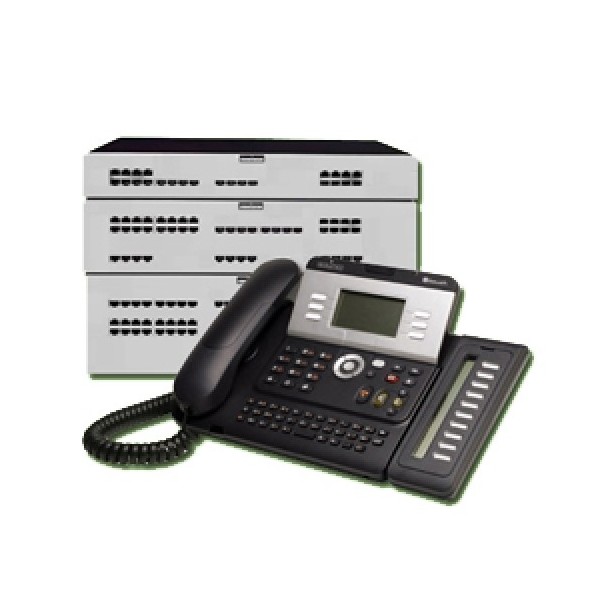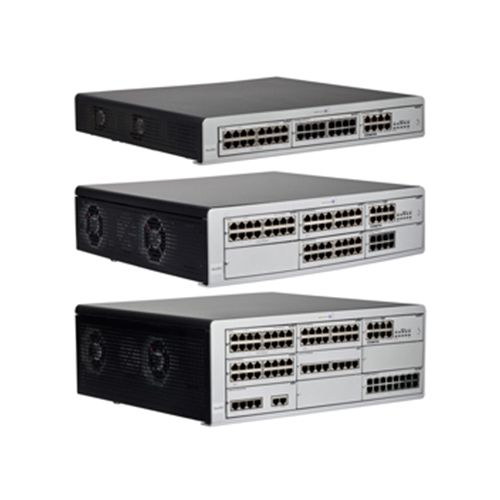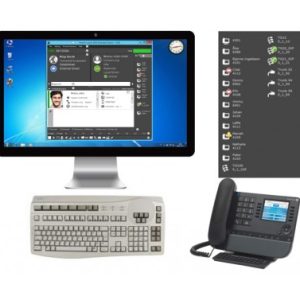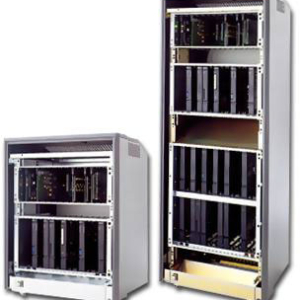Description
Alcatel OmniPCX Office has a flexible architecture with flexible scalability and can support:
+ 236 users
+ 200 IP clients
+ 236 ReflexesTM digital terminals
+ 196 analog terminals
+ 120 DECT standard cordless phones or PWT base stations
+ 72 analog trunks
+ 96 IP trunks
+ 3000 links and phone numbers in the phone book

Profiles of the system:
– Network interface:
+ Analog CO trunk interface for DTMF/DP signaling
+ Trunk interface E1,T1,T2 signals CAS/R2
+ ISDN S0 trunk interface signaling DSS1/QSIG/PSS1/DPNSS1
+ ISDN S2M trunk interface signaling DSS1/QSIG/PSS1/DPNSS1
+ IP Ethernet 10/100 network interface for connecting voice and video terminals using IP according to H.323/SIP standard. The IP terminals must be able to use all of the system’s services like a regular subscription. Allows uniform connection of systems to each other based on IP network infrastructure (IP trunking).
– Subscriber interface:
+ Telephone, regular fax machine
+ Phone number
+ IP terminals, support VoIP capability
+ ISDN S0 (2B+D) with both U interface and S/T interface
+ ISDN S2M (30B+D) to connect to secondary systems
+ nx64Kbps interface for data transfer
+ H interfaces for multimedia and video conferencing equipment according to H.320 standard
+ DECT/GAP wireless subscribers
– Admin/application interface:
+ V.24, synchronous or heterogeneous, up to 115 kbit/s.
+ Ethernet 10/100Base – T
+ TCP/IP, PPP, FTP, HTTP, CSTA, TAPI/JTAPI protocols.
– Application interface: The system provides interfaces for computer-to-phone (CTI) integrated applications at both 1st party and 3rd party levels and supports the following protocols:
+ Microsoft TAPI 2.1/3.0
+ JTAPI

Basic features of the system:
– Flexible numbering ability: the number analysis of Alcatel OmniPCX Office call center has many advantages:
+ The internal numbering plan allows internal machine numbers to be numbered from 1 to 8 digits, the number of digits of the extensions may be uneven.
+ The dial-out numbering plan allows 6 digits to define the code occupying the trunk. The dial-in numbering plan allows DIDs (Direct Inward Dialling) numbers to have up to 8 digits.
+ Service access codes can also be numbered from 1 to 8 digits (including *, #, A, B, C, D) and allow for substitutions for *, # for subscribers using the Pulse Rotation (DP) style
+ The system is capable of analyzing and storing numbers up to the 20th digit.
– Waiting music and notifications: Alcatel-Lucent OmniPCX Office supports standby tracks and pre-recorded notifications in the ROM memory. Calls from outside or internally can be heard with instructions and music while on standby. Caller The system also allows you to define multiple notification ports and standby music ports to connect to external notification or music transmitters (catssette players, CD players, etc.). Each standby music port allows calls to be connected together.
– Call in with the support of the operator: The system allows the program to direct calls from certain trunks to the operator’s desk (or any subscriber), and the operator (or defined subscriber) will relay the call to the internal subscriber as required. It is possible to define up to 8 groups of operators, each group consisting of many operators responsible for supporting a group of subscribers and trunks of the system.
– Direct InwardDialing (DID) The system can be programmed to allow callers from outside the system through certain trunks to dial the numbers to be connected to internal subscribers without intermediaries. A direct dial in (DID) number doesn’t have to be the same as a subscriber number. Cases of non-dialing, missing dialing, dialing wrong numbers, busy subscribers, subscribers not answering can be programmed to ring the operator’s desk. Notification devices can be used to broadcast greetings or dialing instructions to callers coming from outside. Different relay groups may have different announcement sentences.
– Direct Inward System Access: The system allows external employees to call into the system, log in with a password, activate the services provided by the system to them (redirect calls, do not disturb, etc.) or continue to occupy the long-distance call trunk to charge their account.
– Smart routing: It is possible to set different routes (call directions), each of which can consist of many groups of trunks with different priorities that are flexibly selected to slide. The system allows the analysis of outgoing number sequences up to the 20th digit. The system also allows playback, inserting or subtracting one or more digits from the number sequence before sending it to the enemy switchboard. The routes are selected based on the number sequence turned, the status of the relay groups and by time of day (choose the cheapest route based on the channel rental price by free time, peak hours – Least Cost Routing). The system also has the ability to reroute, automatically re-select another direction when the selected direction has a congestion signal from an intermediary PBX.
– Uniform network connectivity: Alcatel OmniPCX Office is capable of perfect networking via IP, S0, S2M, E1, E&M trunks using ABC protocol (Alcatel’s network connection protocol), R2-Q411, R2-Q211, SS7 or QSIG. At that time, the network is transparent to all subscribers as well as system features. Subscribers of network nodes can call each other and activate services throughout the network no different from the same system. With QSIG international standards, Alcatel OmniPCX Office also allows networking with telephone PBX of other manufacturers that support QSIG. The system allows the possibility of setting up a Virtual Private Network (VPN). Instead of having to rent expensive leased lines, you can use inexpensive dial-up connections over the public network to connect switchboards in different locations.
– Decentralization of service: The system allows decentralization to serve each subscriber. Each subscriber group will be allowed or disallowed to use any services of the system, allowed or not allowed to be called to the public network at many levels such as domestic, county, intra-provincial, inter-provincial, international, etc. or just a certain phone number.
– Accurate billing: Alcatel OmniPCX Office supports both billing methods: time-based and tax-based. The system is capable of recognizing a wide range of charge calculation types including polar reversal pulses, 12KHz, 16KHz and 50Hz pulse types, so it is capable of calculating charges accurately. Call details including date, time of execution, caller number, called, occupied relay, waiting time, talk time, etc. are recorded on hard disks, Flash memory for long-term storage and continuously sent to printers or computers for processing. The simultaneous rendering and storage of charge information on multiple devices ensures high safety for charge calculation. If the price is pre-entered according to the area code, time or pulse, the system can automatically calculate the price displayed on the screen of the operator, number phone or take it to a printer or computer for further processing. In particular, Alcatel OmniPCX Office can provide inverted polar charge clocks, 12KHz, 16KHz or 50Hz clocks for self-charged subscribers and public phone cabins.
– Ability to synchronize from multiple sources: The system has a master clock pulse generator in place. This pulse generator can be synchronized with an external synchronous source or a regenerative clock signal from the E1, S2M digital trunks. Synchronous sources can be defined with different synchronization priority levels, and the system will synchronize according to the synchronization source with the highest level priority that is performing well.
– Night service: The system distinguishes two modes of operation day and night (working hours/rest hours). The location of the phone, the service level of each subscriber may be different in the above two modes. This service can be applied to lock subscribers at the end of working hours and transfer all incoming calls after hours to the position of security guards, night duty. Night service can be activated non-automatically by the operator or automatically by the hour of the day.
– Voicemail service (VoiceMail): The system allows the use of voicemail service that allows callers to leave messages for subscribers who are not or cannot answer. Each subscriber has its own voicemail that can be accessed to listen to messages, forward messages to other mailboxes, etc. Subscribers whose messages are signaled by on-screen notifications, flashing LED indicators, or system-issued announcements when picking up the phone. Voicemail devices are connected to the system by regular subscriber gateways, digital subscribers, and ISDN interfaces are defined as voicemail interfaces.
– Computer Telephony Integration (CTI): The system supports computer-computer integration (CTI) applications at both 1st and 3rd party levels, allowing computer applications to perform phone functions or interfere with call control processes. CSTA, TAPI, TSAPI standard CTI protocols via V.24 or Ethernet physical connections are supported.
– Management and maintenance features
+ The system provides V.24 ports and LAN interfaces for maintenance management devices (UA equipment terminals, VT100, PCs, printers). Through procedures and management/maintenance orders entered from the keyboard, the manager can review, diagnose, and change the parameters of the system.
+ Warnings are displayed on the spot by lights displayed on the card or by real-time messages on the screen of the operator and management equipment (computers, printers, etc.) so that the manager can know the exact location and type of error. The error messages contain full information about the origin, location, and cause of the problem. There are also notifications that predict possible problems in advance.
+ Errors when giving direct warnings are also stored in the system hard drive, helping managers to look up the process of errors and real-time errors that have occurred.
+ The monitoring management system uses a clear, easy-to-understand, easy-to-remember, and easy-to-use human-machine interface and language that allows managers to master the equipment easily and quickly.
+ The system verifies access by name and password and allows administrative decentralization. Each administrator has different permissions (change, view, delete, scope of impact, etc.). All transactions (changes, deletions, edits, restarts) of every session of all administrators are recorded and can be reviewed.





Reviews
There are no reviews yet.